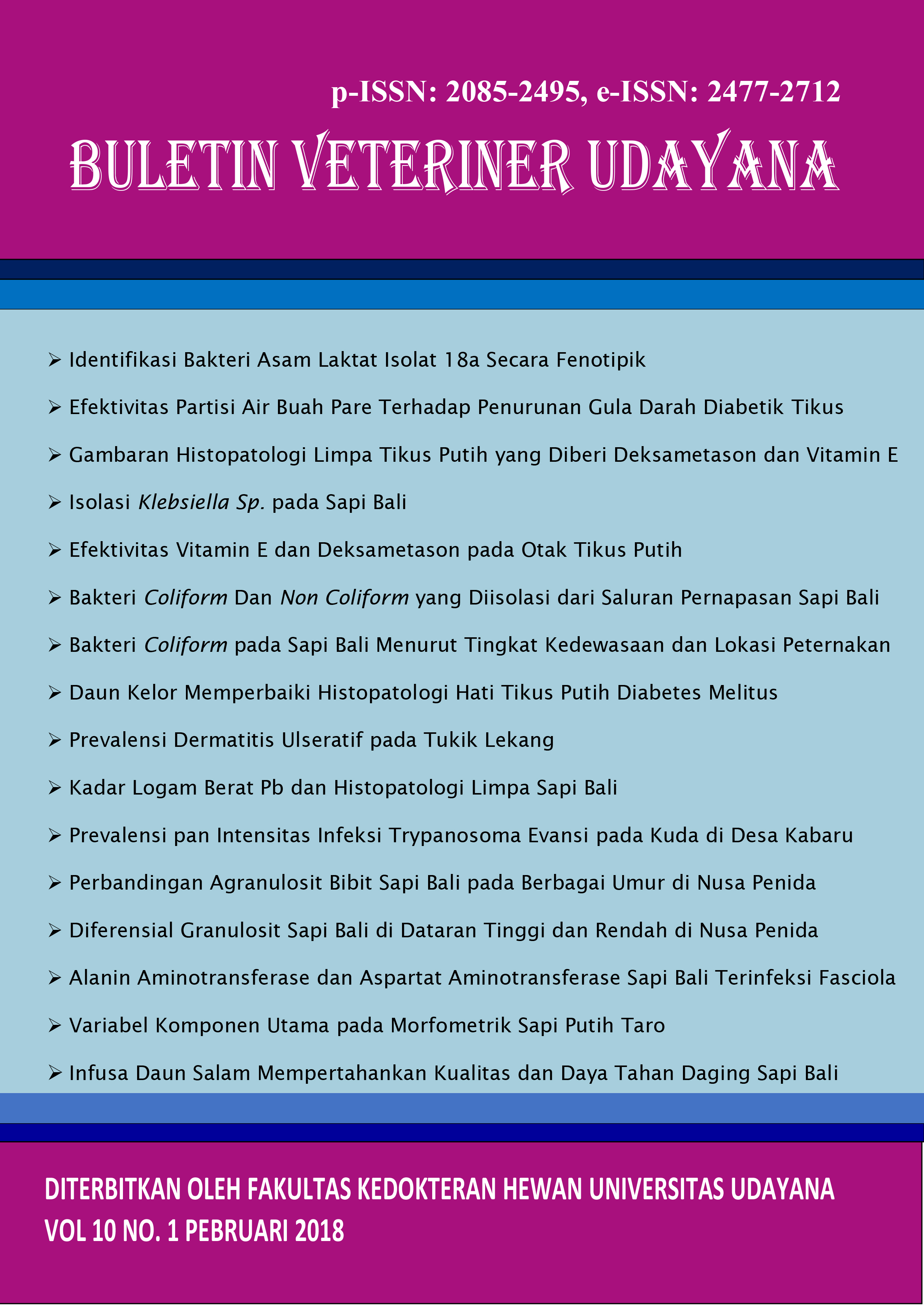PREVALENCE OF ULCERATIVE DERMATITIS IN OLIVE RIDLEY HATCHLINGS REARED AT TURTLE CONSERVATION AND EDUCATION CENTRE SERANGAN
Abstract
Ulcerative dermatitis is a disease that most commonly affects turtles and/or hatchlings that are kept in ponds, including in Turtle Conservation and Education Center (TCEC), Serangan. A study was conducted to determine the prevalence, pathology, and lesion location of ulcerative dermatitis in olive ridley hatchlings reared in TCEC Serangan, also the differences of the body condition index of olive ridley hatchlings with ulcerative dermatitis and healthy ones. Prevalence was determined by counting sick hatchlings compared with the total number of hatchlings at TCEC. Morphometry (straight carapace length, straight carapace width, curved carapace length, curved carapace width) and body weights were measured to determine the body condition index, and then body index differences were compared with unpaired T-Test. Skin tissue samples were processed into pathology slides and routinely staining of hematoxylin eosin (HE). The prevalence of ulcerative dermatitis in olive ridley hatchlings at TCEC was 16.2%. Crusty-yellow wound lesions of 2 mm to 2 cm in diameter were found and microscopically there were heterophils and mononuclear cells infiltration in skin dermis accompanied by erosion, parakeratosis, and necrotic material containing cell debris. Lesions were found mostly on neck area (63.04%), followed by flippers, head, skin near carapace, eyelids, and neck area with flippers combined. There was a very significant difference in body condition index between suffered hatchlings with healthy ones, where the average body condition index of suffered hatchlings were greater than healthy ones. Rearing management should be fixed.
Downloads
References
Bailey T. 2008. Mortality at a hawksbill turtle (Eretmochelys imbricata) Rearing Center. Wildlife Middle East News. 3(2): 1-3.
Berata IK, Winaya IBO, Adi AAAM, Adnyana IBW. 2015. Patologi Veteriner Umum. Swasta Nulus. Denpasar
Bjorndal KA, Bolten AB, Chaloupka MY. 2000. Green turtle somatic growth model: evidence for density dependence. Ecol. Appl. 10: 269-282.
Chaloupka M, Work TM, Balazs GH, Murakawa SKK, Morris R. 2008. Cause-specific temporal and spatial trends in green sea turtle strandings in the Hawaiian Archipelago (1982-2003). Mar. Biol. 154: 887-898.
Ernst CH, Lovich JE. 2009. Turtles of the United States and Canada. Ed. 2. JHU Press. Baltimore
Lutz PL, Musick JA, Wyneken J. 2003. The Biology of Sea Turtles. Vol. 2. CRC Press. Florida
Markey BK, Leonard FC, Archambault M, Cullinane A, Maguire D. 2013. Clinical Veterinary Microbiology. Ed. 2. Mosby Elsevier. London
Muñoz FA, Estrada-Parra S, Romero-Rojas A, Gonzales-Ballesteros E, Work TM, Villaseñor-Gaona H, Estrada-Garcia I. 2013. Immunological Evaluation of the Captive Green Sea Turtle (Chelonia mydas) with Ulcerative Dermatitis. J. Zoo and Wildlife Med. 44(4): 837-844.
Orós J, Torrent A, Calabuig P, Déniz S. 2005. Diseases and Causes of Mortality among Sea Turtles Stranded in the Canary Islands, Spain (1998-2001). Dis. Aquat. Org. 63: 13-24.
Orós J, Montesdeoca N, Camacho M, Arencibia A, Calabuig P. 2016. Causes of Stranding and Mortality, and Final Disposition of Loggerhead Sea Turtles (Caretta caretta) Admitted to a Wildlife Rehabilitation Center in Gran Canaria Island, Spain (1998-2014): A Long-Term Retrospective Study. PLoS ONE. 11(2): e0149398.
Reavill DR, Melloy M, Schmidt ER. 2004. Reptile mycotic infections from the literature and 55 cases, In : Proceedings. Association of Reptilian and Amphibian Veterinarians. Naples, USA, 8-11 Mei 2004. Pp: 62-71.
Swain P, Behura A, Dash S. 2007. Serum antibody response of Indian major carp, Labeo rohita, to three species of pathogenic bacteria; Aeromonas hydrophila, Edwardsiella tarda and Pseudomonas fluorescens. Vet. Immunol. Immunopathol. 117:137-141.





